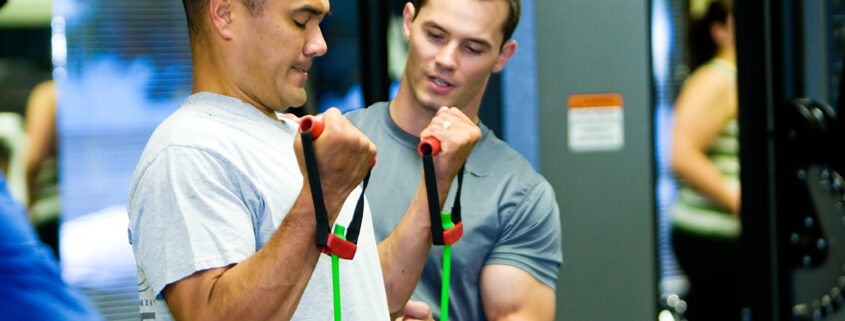If you spend a lot of time at the gym, why not get paid for it? Personal trainers make a good living, after all. Why not cash in on your love of the fitness lifestyle and become a personal trainer?
No matter what your background is, there’s a niche in the fitness world that you can likely fit seamlessly into, from working with athletes to keeping older adults fit, to helping people return to exercise after an injury or illness.
Careers are abundant and the industry continues to grow, so jump on the trend now and make a living while you do it. Here’s how to become a personal trainer.
What Does a Personal Trainer Do?
The basic duty that a personal trainer performs is to create customized exercise plans for clients to help them reach their fitness goals. They are well trained in anatomy and physiology and use that knowledge to design a workout program that fits the needs of the individual.
A personal trainer may work with one person at a time or conduct group sessions to instruct several people in a similar way at one time. They might also coach sports teams, work in rehab facilities, create gym programs, or instruct fitness classes.
Personal trainers do not offer medical advice and cannot diagnose health problems. They cannot create customized meal plans either.
They can collaborate with other health professionals as part of a team to help you be the healthiest you can be.
Sound interesting? Keep reading to see if you’ve got what it takes with these handy tips for becoming a personal trainer.
Personal Trainer Prerequisites
Before you can begin a personal trainer course, you must meet some requirements, including being at least 18 years of age and having a current CPR and AED certification.
Most certifying agencies also require you to have a high school diploma or GED.
How to Become a Personal Trainer
If you meet the requirements and are ready to get started, there’s a path that you must follow to become a certified personal trainer. That path starts with choosing your certification program.
There are several to choose from and you need to be sure that the one you choose is accredited, which lends it credibility. The National Academy of Sports Medicine and the American Council on Exercise are two of the most popular programs.
While a college degree is not required to pursue a personal trainer certification, many people have a background in exercise science or kinesiology. This often gives them a leg up when studying for the personal trainer exam.
You might decide that having a bachelor’s degree is important to you and it creates a strong stepping stone for your future endeavors in the field.
The Certification Program
Each program varies on how the information is presented, but you can likely expect to have a set of materials that will guide your studies. This usually includes a textbook and study guide.
Often, lectures and webinars are used in conjunction with these materials. As you progress through the program, you’ll learn anatomy and exercise science techniques.
These will teach you to choose the right exercises for clients in a variety of situations. That includes those who want to build muscle, are overweight or obese, and have health conditions like arthritis or diabetes.
You’ll also learn about the skeletal system and will be able to identify the muscles in the body that are used for various movement patterns. This assists you in learning to customize exercise programs for people with full range of motion and those who struggle with everyday activities.
The Personal Trainer Exam
After you complete the certification program you choose, you will take the personal trainer exam. This exam tests your knowledge of the topics taught in the classes and lectures, and you must achieve a passing score to earn your certification.
The test is pass or fail and if you don’t get through the first time, you can retake it. The exam is typically administered at a testing site, though some organizations offer an online version.
If you prefer one or the other, be sure to ask about the testing process before you choose a program so that you can align your needs with the type of exam offered.
Choose Your Niche
While many personal trainers start out working in a gym, you’ll quickly find that you prefer a certain type of clients, such as women or young athletes. Finding your niche allows you to progress your career.
In addition to working at corporate gyms, many personal trainers work in corporate settings or in hospitals, spas, and wellness centers. Others find fulfilling work on cruise ships, directing exercise classes for vacationers.
Specific niches to consider include athletics, weight management, nutrition coaching, and orthopedics. You might also be drawn to personal training in the medical industry or working with young children.
Going into business for yourself might sound appealing. This is entirely possible as a personal trainer. Due to the flexible nature of the job, there are a lot of ways to open your own place.
Whether you want a brick-and-mortar gym of your own or you see clients in their own homes, the advantages of working for yourself are plentiful. That includes a personal trainer salary that rivals those working in other settings.
Continuing Education
Like many careers, you’ll have to keep up with the latest trends and innovations in the fitness industry to keep your certification current and valid. You can take continuing education courses through your certifying agency.
You can also take them through other organizations that track your progress and contribute the credits to your certificate. This is an exciting way to stay on top of what’s happening in the industry.
Ready to get started on learning how to become a personal trainer? Let Vim Fitness help you build your career and get people moving.
















